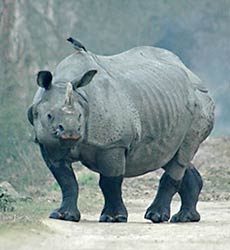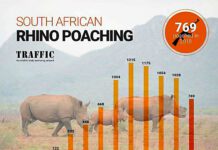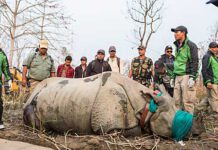
The greater one-horned rhinoceros is no longer ‘endangered’, according to the 2008 IUCN Red List update. This, despite the fact that a single epidemic could wipe out about three quarters of the world’s population which inhabits Kaziranga National Park in Assam. The total world population of these rhinos is about 2700.
In the updated version of the list which is internationally accepted as an authority on the conservation status of the listed species, the rhino, found in the Indian subcontinent, has been downgraded to ‘vulnerable’, confounding conservationists.
“It’s the simple logic of most eggs in one basket; with the world’s largest population of greater one-horned rhinoceros concentrated in Kaziranga, the species is at risk,” says Vivek Menon, Executive Director of Wildlife Trust of India (WTI) and a member of IUCN-SSC Rhino Specialist Group, expressing his surprise at the decision.
The drastic rise in poaching of rhinos over the last two years in Kaziranga makes the Red List ‘demotion’ even more inexplicable.
“Poaching occurs in waves. Although rhino poaching in Kaziranga was relatively low over the last decade, the toll in 2007 reached 23, a sharp increase from the single digit toll of the previous several years,” says Professor PC Bhattacharjee of Gauhati University.
Also, flood is an annual phenomenon in this world heritage site. Each year, flood accounts for wild animals including varying number of rhinos being washed away or drowned in Kaziranga. Increase in poaching has also been associated with rise in water levels. Animals move out of the park to higher grounds to escape drowning, but instead, fall prey to poachers who lurk in the unprotected areas.
Historically found throughout the Brahmaputra Valley, rhino population in Assam is now limited to just Kaziranga, Orang and Pobitora.
To tackle this threat of increasing genetic isolation, conservation groups have been striving to expand the home range of these rhinos. In 2006, the Assam Forest Department along with WTI and its partner International Fund for Animal Welfare (IFAW) initiated a rhino reintroduction project in Manas National Park. The project clubs reintroduction of rhinos in Manas, which lost all its rhinos to poachers by the year 2000, with rehabilitation of permanently displaced rhino calves from Kaziranga. This has been followed by relocation of rhinos from Pobitora Wildlife Sanctuary to Manas NP under the Rhino Vision 2020 project.
In Chitwan National Park in Nepal, the world’s second stronghold for the greater one-horned rhinos, the population is showing a comeback. About 408 rhinos were counted in the census carried out in 2008 as against about 372 in 2005. However, the positive news ends here; like Kaziranga, Chitwan too is an isolated success story. Rhino population in Bardia NP, second in significance after Chitwan, has also been suffering at the hands of poachers.
In addition to the greater one-horned rhino, the updated Red list also lowers the conservation status of the humpback whale and African elephants, among other mammals.
The humpback whale has been re-classified as species of ‘least concern’, a phrase that conservationists say “communicates a wrong signal”.
“How can any species be termed as of ‘least concern’ with the world’s biodiversity facing unprecedented threats of climate change, deforestation and poaching?” asks Menon. “A species can be at ‘lower risk’ (which was the phrase used earlier) as compared to other species, but to say that it is of ‘least concern’ is a heresy for conservationists,” he feels.
These species are among “five percent of the currently threatened mammals showing signs of recovery in the wild” and are listed under ‘genuine improvements’ in the recently released IUCN list.
Common leopard, fishing cat, sambar, Chinese pangolin and greater slow loris are among the species found in India, whose status of endangerment has increased according to IUCN.
The red list warns that about one in four species of mammals of the world is nearing extinction.
“The threats to greater one-horned rhinos have not decreased, and its conservation status should not have been changed. Likewise for African elephants, poaching is reported to be on rise especially in view of the CITES-approved second stockpiled ivory sale scheduled for next week. At this critical time, these changes by IUCN can have a profoundly negative impact on populations of these species, as they can be easily quoted out of context or be put to mischievous use,” cautions Menon.
Along with the updated Red List, the IUCN has also announced an Indian as its new President. Dr Ashok Khosla, Chairman of Development Alternatives- a social enterprise promoting sustainable development, replaces Valli Moosa who had been at the helm since the third IUCN World Conservation Congress, held in Bangkok, Thailand in November 2004.
Press Release: Wildlife Trust of India WTI / October 22, 2008, www.wildlifetrustofindia.org









